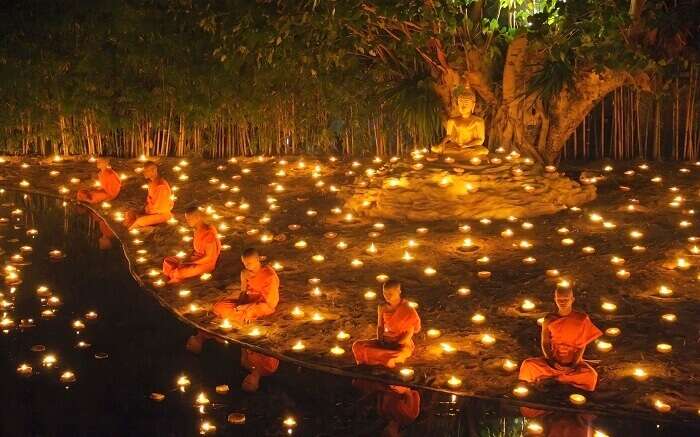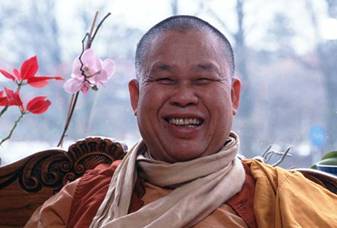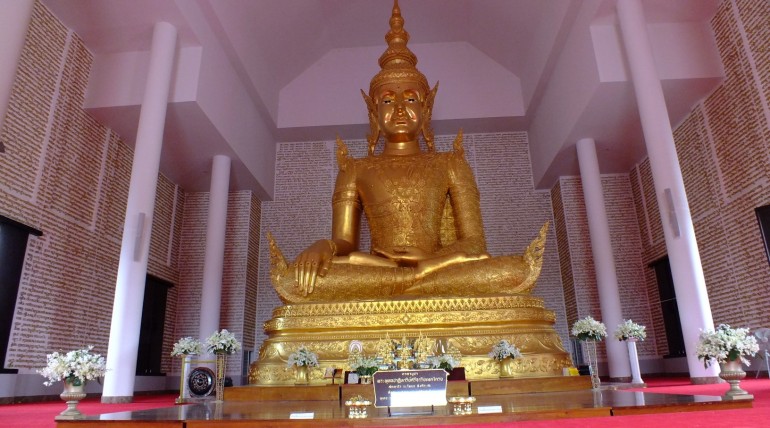Vesak day is a significant day for Buddhists all over the world. It’s the full moon day of the fourth lunar month, the month of Vaisakh. It is the month when the Buddha was born, attained enlightenment, and died. In Thailand, they say the Buddha was born 2564 years ago. The Buddha was a prince of a small Shakyan kingdom in Kapilavastu – today’s Lumbini, Nepal which borders India. He was the firstborn son of King Suddhodana and Queen Mahamaya and they named him Siddhartha. At Siddhartha’s birth, the king had 12 astrologers make a birth chart and they all said he would grow up to become either an emperor or a Buddha. The youngest astrologer, Koṇḍañña, said Siddhartha would eventually become a Buddha
Early Life of the Buddha
King Suddhodana wanted Siddhartha to become a king and prevented him from seeing any suffering. He built three palaces, each for one of the seasons of the year for the future Buddha. Siddhartha enjoyed all kinds of luxury and pleasures a human being could have. He was arranged to be married at age 16 to princess Yasodhara.
At the age of 29, Siddhartha managed to sneak out of the palace with his servant Chanda, and he saw a sick person, old person, and dead person for the first time in his life. He asked Chanda if growing old, falling sick, and dying is the fate of everyone. Chanda replied it is everyone’s fate to suffer sickness, old age, and death. Siddhartha was really shaken that everyone he loved, including himself, would have to suffer these stages of life. Later, Siddhartha saw an ascetic and asked Chanda what he was doing sitting under the tree. Chanda answered that the ascetic was looking for a way to overcome suffering.
When princess Yasodhara gave birth to a son, Siddhartha named him Rahula – which means fetter, a chain. He reflected that his son would be a chain of bond for him if he were to carry his newborn. On the same day Rahula was born, Siddhartha left the palace to find a way out of birth, sickness, old age, and death. He gave up his jewels, clothes and cut his hair to find a teacher to teach him a way out of suffering.
The Search
Siddhartha’s first teacher was Alara Kalama, who taught him up to the 4th level of jhana (4th meditative absorption). Siddhartha reached the 4th jhana quickly but found it could not solve his sufferings. So he left Kalama and found Uddaka Ramaputta, who taught Siddhartha up to the 8th level of jhana. Siddhartha also attained this level quickly, and his teacher asked him to stay and help him teach at the ashram. The future Buddha declined, saying he still had not found a way out of suffering.
When Ramaputta said he had nothing else left to teach him, Siddhartha departed to try extreme asceticism. He wouldn’t eat or sleep. He would stand on one leg and punish his body to overcome suffering. Koṇḍañña, the astrologer who predicted Siddhartha’s enlightenment, followed the future Buddha along with 4 other ascetics to wait for the prince’s enlightenment. Siddhartha’s practice was so extreme, he recalled putting his finger to his stomach and being able to feel his backbone.
The Middle Way
One day, while sitting under a tree, he heard a sitar teacher teaching his students passing by on a boat. The teacher told his students if they wanted to play the sitar well, they had to tighten the strings just right. If the strings are too loose, there is no good sound. If the strings are too tight then they will break. Siddhartha reflected on his own practice and realized he would die before enlightenment if he carried on with extreme asceticism. He realized both pleasures and asceticism do not end suffering. Thus, Siddhartha decided to end his asceticism by eating.
It so happened, a young woman named Sujata was on her way to offer a special offering to a tree for blessing her a good husband and a son. She had cream from a thousand cows which she boiled for a long time and added honey. She thought Siddhartha was the tree spirit and offered him the food in a golden bowl. He regained his strength after eating and took the golden bowl to the river making a determination, “If I should attain enlightenment, let the bowl go against the stream.” He placed the bowl into the river and it flowed against the stream of the river. The Buddha then went to Bodh Gaya. By this time, his 5 ascetic followers had left him after he took food to end his asceticism.
The Enlightenment
Siddhartha found a tree at Bodh Gaya to sit. He was determined not to get up even if his blood dried up until he reached enlightenment. Recalling his experience of the 1st jhana as a child sitting under a tree during a royal plowing festival=, he drifted into the meditative absorption by relaxing. Siddhartha then relaxed and entered the 1st jhana and knowledge arose in him. In the first watch of the night, he received the knowledge of past lives. He recalled all his past lives and the past lives of all beings. In the second watch of the night, he understood the law of kamma. In the third watch of the night, he understood how to overcome all attachments to reach complete freedom from suffering.
Overcoming Mara
When something special like this happens, hindrances or obstacles will arise. It happens not only to the Buddha but to all of us. This is when we have to show the strength to overcome and not to give in. At this time, Mara (or the devil) came and he sent his beautiful 3 daughters to tempt Siddhartha. But Siddhartha stayed equanimous.
Mara then sent his army of frightening demons shooting burning arrows at the Buddha, who stayed calm and sent metta (loving-kindness), turning the arrows into flowers. Although it sounds like a fairytale, the meaning of the Buddha’s encounter with Mara is our own experience in meditation. We experience hindrances such as sensual lust, represented by Mara’s daughters, fear and ill will, represented by Mara’s army. When we attach to sensual experiences in our meditation we may get attached and not reach our real goal. We may also experience mental obstacles that cause us fear. Siddhartha stayed equanimous amidst lust and fear in his encounter with Mara. Siddhartha emerged victorious against Mara and became the Buddha with complete enlightenment.
The Buddha continued sitting under the Bodhi tree for 7 days. You can still see the path where the Buddha walked up and down near the Bodhi tree for another 7 days. He was also doing standing meditation for 7 days gazing at the Bodhi tree in gratitude for providing him with shelter. The first words uttered by the Buddha upon emerging from enlightenment was, “Housebuilder, you are seen. You shall build no house again. All your rafters are broken, the ridge-pole shattered. My mind has attained the unconditioned. Achieved is this end of craving.” That’s the mind the Buddha is referring to. Our mind is always building concepts of me, mine, and self that always lead us to suffer.
Turning the Dhamma Wheel
The Buddha thought that this knowledge is too difficult for beings to understand. Then Sahampati the king of Brahmas and Indra the king of devas came to ask the Buddha to teach as there are beings who have little dust in their eyes. The Buddha then agreed and he remembered the 5 ascetics and could see with his inner eye they were at Varanasi. He walked there to give them the teaching of the Four Noble Truths, setting the Dhamma Wheel turning. Koṇḍañña the astrologer, became the first to attain the first step of enlightenment and therefore became the Buddha’s first disciple.
Another important thing to remember on Vesak Day is the Buddha’s entrance into parinibbana. That happened when he was 80 years old in Kushinagar. He died there under the sala tree and entered nibbana. His birth and death both took place during the full moon in the fourth lunar month of the year.
Thai people celebrate Vesak day by visiting the temples to make merit. But it is very quiet at this time during the pandemic. On Vesak day, you can make merit by practicing ethical principles such as determining not to drink alcohol. All the merits and determinations you make can multiply. Or do anything that is wholesome to celebrate Vesak Day to help with your meditation.
I wish you a very good Vesak Day.



